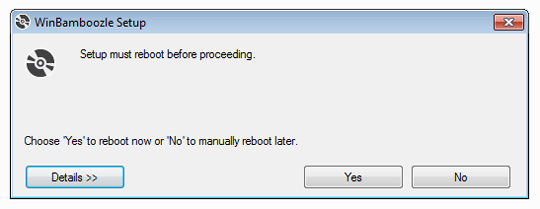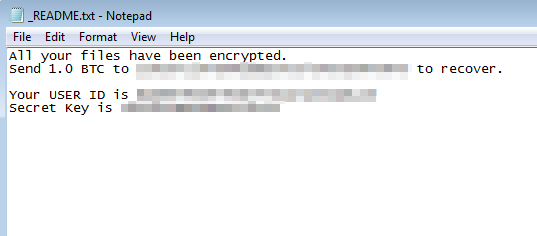RANSOM_WINBAM.A
N/A
Windows


Threat Type: Ransomware
Destructiveness: No
Encrypted: No
In the wild: Yes
OVERVIEW
Downloaded from the Internet
This Ransomware arrives on a system as a file dropped by other malware or as a file downloaded unknowingly by users when visiting malicious sites.
It encrypts files found in specific folders. It drops files as ransom note.
TECHNICAL DETAILS
280739 bytes
ZIP
No
19 Jun 2017
Connects to URLs/IPs, Displays message/message boxes, Encrypts files
Arrival Details
This Ransomware arrives on a system as a file dropped by other malware or as a file downloaded unknowingly by users when visiting malicious sites.
Installation
This Ransomware drops the following files:
- %AppDataLocal%\Temp\VSD{4 random chars}.tmp\install.log <- installation log
- %AppDataLocal%\Temp\VSD{4 random chars}.tmp\afterreboot.cfg
- %AppDataLocal%\Temp\VSD{4 random chars}.tmp\setup.exe <- copy of itself
- %AppDataLocal%\Temp\VSD{4 random chars}.tmp\DotNetFX461\NDP461-KB3102438-Web.exe <- installs .NET Framework
- %AppDataLocal%\Apps\2.0\{8 random chars}.{3 random chars}\{8 random chars}.{3 random chars}\manifests\winb...exe_{16 random chars}_0001.0000_none_{16 random chars}.cdf-ms
- %AppDataLocal%\Apps\2.0\{8 random chars}.{3 random chars}\{8 random chars}.{3 random chars}\manifests\winb...exe_{16 random chars}_0001.0000_none_{16 random chars}.manifest
- %AppDataLocal%\Apps\2.0\{8 random chars}.{3 random chars}\{8 random chars}.{3 random chars}\manifests\winb..tion_{16 random chars}_0001.0000_none_{16 random chars}.cdf-ms
- %AppDataLocal%\Apps\2.0\{8 random chars}.{3 random chars}\{8 random chars}.{3 random chars}\manifests\winb..tion_{16 random chars}_0001.0000_none_{16 random chars}.manifest
- %AppDataLocal%\Apps\2.0\{8 random chars}.{3 random chars}\{8 random chars}.{3 random chars}\winb...exe_{16 random chars}_0001.0000_none_{16 random chars}\WinBamboozle.exe.config
- %AppDataLocal%\Apps\2.0\{8 random chars}.{3 random chars}\{8 random chars}.{3 random chars}\winb..tion_{16 random chars}_0001.0000_{16 random chars}\WinBamboozle.cdf-ms
- %AppDataLocal%\Apps\2.0\{8 random chars}.{3 random chars}\{8 random chars}.{3 random chars}\winb..tion_{16 random chars}_0001.0000_{16 random chars}\WinBamboozle.exe
- %AppDataLocal%\Apps\2.0\{8 random chars}.{3 random chars}\{8 random chars}.{3 random chars}\winb..tion_{16 random chars}_0001.0000_{16 random chars}\WinBamboozle.exe.cdf-ms
- %AppDataLocal%\Apps\2.0\{8 random chars}.{3 random chars}\{8 random chars}.{3 random chars}\winb..tion_{16 random chars}_0001.0000_{16 random chars}\WinBamboozle.exe.config
- %AppDataLocal%\Apps\2.0\{8 random chars}.{3 random chars}\{8 random chars}.{3 random chars}\winb..tion_{16 random chars}_0001.0000_{16 random chars}\WinBamboozle.exe.manifest
- %AppDataLocal%\Apps\2.0\{8 random chars}.{3 random chars}\{8 random chars}.{3 random chars}\winb..tion_{16 random chars}_0001.0000_{16 random chars}\WinBamboozle.manifest
- %AppDataLocal%\Temp\ASPNETSetup_00000.log
- %AppDataLocal%\Temp\dd_NDP461-KB3102438-Web_decompression_log.txt
- %AppDataLocal%\Temp\dd_SetupUtility.txt
- %AppDataLocal%\Temp\dd_TMPC356.tmp_decompression_log.txt
- %AppDataLocal%\Temp\dd_wcf_CA_smci_20180612_001709_686.txt
- %AppDataLocal%\Temp\Deployment\{8 random chars}.{3 random chars}\{8 random chars}.{3 random chars}.application
- %AppDataLocal%\Temp\Deployment\{8 random chars}.{3 random chars}\WinBamboozle.exe.manifest
(Note: %AppDataLocal% is the Application Data folder found in Local Settings, where it is usually C:\Documents and Settings\{user name}\Local Settings\Application Data on Windows 2000, Windows Server 2003, and Windows XP (32- and 64-bit); C:\Users\{user name}\AppData\Local on Windows Vista (32- and 64-bit), Windows 7 (32- and 64-bit), Windows 8 (32- and 64-bit), Windows 8.1 (32- and 64-bit), Windows Server 2008, and Windows Server 2012.)
It creates the following folders:
- %AppDataLocal%\Temp\Deployment
- %AppDataLocal%\Temp\Deployment\{8 random chars}.{3 random chars}
- %AppDataLocal%\Apps
- %AppDataLocal%\Apps\2.0
- %AppDataLocal%\Apps\2.0\Data
- %AppDataLocal%\Apps\2.0\{8 random chars}.{3 random chars}
- %AppDataLocal%\Apps\2.0\{8 random chars}.{3 random chars}\{8 random chars}.{3 random chars}
- %AppDataLocal%\Apps\2.0\{8 random chars}.{3 random chars}\{8 random chars}.{3 random chars}\manifests
- %AppDataLocal%\Apps\2.0\{8 random chars}.{3 random chars}\{8 random chars}.{3 random chars}\winb...exe_{16 random chars}_0001.0000_none_{16 random chars}
- %AppDataLocal%\Apps\2.0\Data\{8 random chars}.{3 random chars}\{8 random chars}.{3 random chars}\winb..tion_{16 random chars}_0001.0000_{16 random chars}\Data
- %AppDataLocal%\Apps\2.0\{8 random chars}.{3 random chars}\{8 random chars}.{3 random chars}\winb..tion_{16 random chars}_0001.0000_{16 random chars}
- %AppDataLocal%\Temp\VSD{4 random chars}.tmp
- %AppDataLocal%\Temp\VSD{4 random chars}.tmp\DotNetFX461
(Note: %AppDataLocal% is the Application Data folder found in Local Settings, where it is usually C:\Documents and Settings\{user name}\Local Settings\Application Data on Windows 2000, Windows Server 2003, and Windows XP (32- and 64-bit); C:\Users\{user name}\AppData\Local on Windows Vista (32- and 64-bit), Windows 7 (32- and 64-bit), Windows 8 (32- and 64-bit), Windows 8.1 (32- and 64-bit), Windows Server 2008, and Windows Server 2012.)
Download Routine
This Ransomware accesses the following websites to download files:
- http://download.microsoft.com/download/3/5/9/35980F81-60F4-4DE3-88FC-8F962B97253B/NDP461-KB3102438-Web.exe <- non-malicious file, it is executed to ensure that the malware runs in the proper .NET Framework
Other Details
This Ransomware connects to the following URL(s) to check for an Internet connection:
- http://go.microsoft.com/
It does the following:
- This malware is a ZIP file containing the following files:
- {malware extraction path}\full\Application Files
- {malware extraction path}\full\Application Files\WinBamboozle_1_0_0_0
- {malware extraction path}\full\Application Files\WinBamboozle_1_0_0_0\WinBamboozle.application
- {malware extraction path}\full\Application Files\WinBamboozle_1_0_0_0\WinBamboozle.exe.config.deploy
- {malware extraction path}\full\Application Files\WinBamboozle_1_0_0_0\WinBamboozle.exe.deploy
- {malware extraction path}\full\Application Files\WinBamboozle_1_0_0_0\WinBamboozle.exe.manifest
- {malware extraction path}\full\Test
- {malware extraction path}\full\Test\data.txt
- {malware extraction path}\full\setup.exe
- {malware extraction path}\full\WinBambozzle.application
- It requires reboot after installation

- The malware is still in development and only encrypt files found in %AppDataLocal%\Apps\2.0\{8 random chars}.{3 random chars}\{8 random chars}.{3 random chars}\winb..tion_{16 random chars}_0001.0000_{16 random chars}\Test displaying a command prompt during encryption

Ransomware Routine
This Ransomware encrypts files found in the following folders:
- %AppDataLocal%\Apps\2.0\{8 random chars}.{3 random chars}\{8 random chars}.{3 random chars}\winb..tion_{16 random chars}_0001.0000_{16 random chars}\Test
(Note: %AppDataLocal% is the Application Data folder found in Local Settings, where it is usually C:\Documents and Settings\{user name}\Local Settings\Application Data on Windows 2000, Windows Server 2003, and Windows XP (32- and 64-bit); C:\Users\{user name}\AppData\Local on Windows Vista (32- and 64-bit), Windows 7 (32- and 64-bit), Windows 8 (32- and 64-bit), Windows 8.1 (32- and 64-bit), Windows Server 2008, and Windows Server 2012.)
It appends the following extension to the file name of the encrypted files:
- .{5 random chars}
It drops the following file(s) as ransom note:
- %AppDataLocal%\Apps\2.0\{8 random chars}.{3 random chars}\{8 random chars}.{3 random chars}\winb..tion_{16 random chars}_0001.0000_{16 random chars}\Test\_README.txt

SOLUTION
9.850
13.482.08
20 Jun 2017
13.483.00
21 Jun 2017
Step 1
Before doing any scans, Windows XP, Windows Vista, and Windows 7 users must disable System Restore to allow full scanning of their computers.
Step 2
Note that not all files, folders, and registry keys and entries are installed on your computer during this malware's/spyware's/grayware's execution. This may be due to incomplete installation or other operating system conditions. If you do not find the same files/folders/registry information, please proceed to the next step.
Step 3
Search and delete these folders
- {malware extraction path}\full
- %AppDataLocal%\Temp\VSD{4 random chars}.tmp
- %AppDataLocal%\Temp\Deployment
- %AppDataLocal%\Apps
Step 4
Search and delete these files
- %AppDataLocal%\Temp\ASPNETSetup_00000.log
- %AppDataLocal%\Temp\dd_NDP461-KB3102438-Web_decompression_log.txt
- %AppDataLocal%\Temp\dd_SetupUtility.txt
- %AppDataLocal%\Temp\dd_TMPC356.tmp_decompression_log.txt
- %AppDataLocal%\Temp\dd_wcf_CA_smci_20180612_001709_686.txt
Step 5
Scan your computer with your Trend Micro product to delete files detected as RANSOM_WINBAM.A. If the detected files have already been cleaned, deleted, or quarantined by your Trend Micro product, no further step is required. You may opt to simply delete the quarantined files. Please check the following Trend Micro Support pages for more information:
Step 6
Restore encrypted files from backup.
Did this description help? Tell us how we did.

